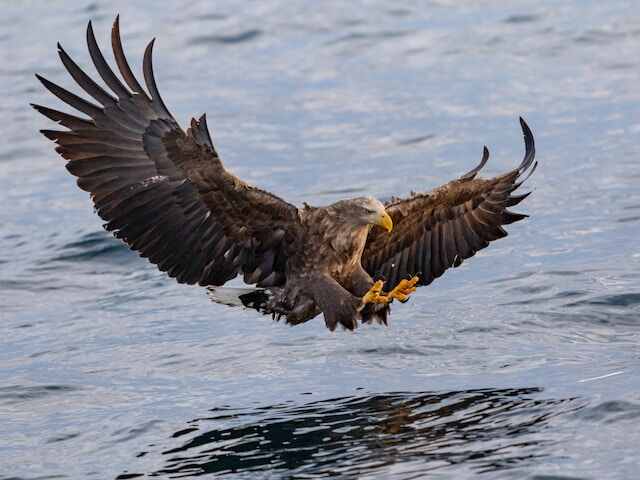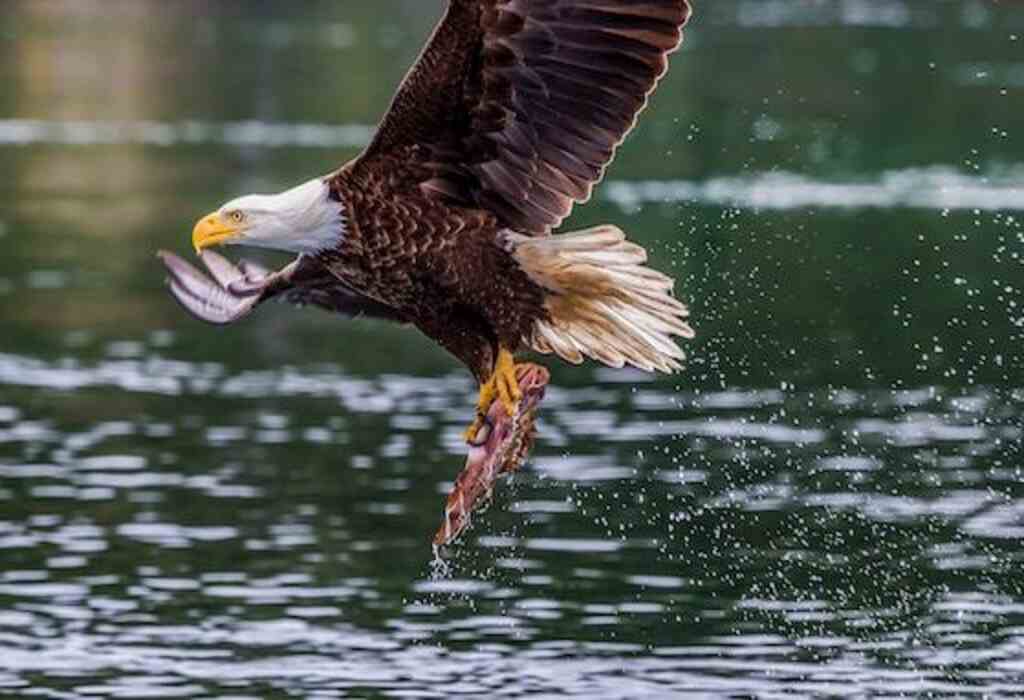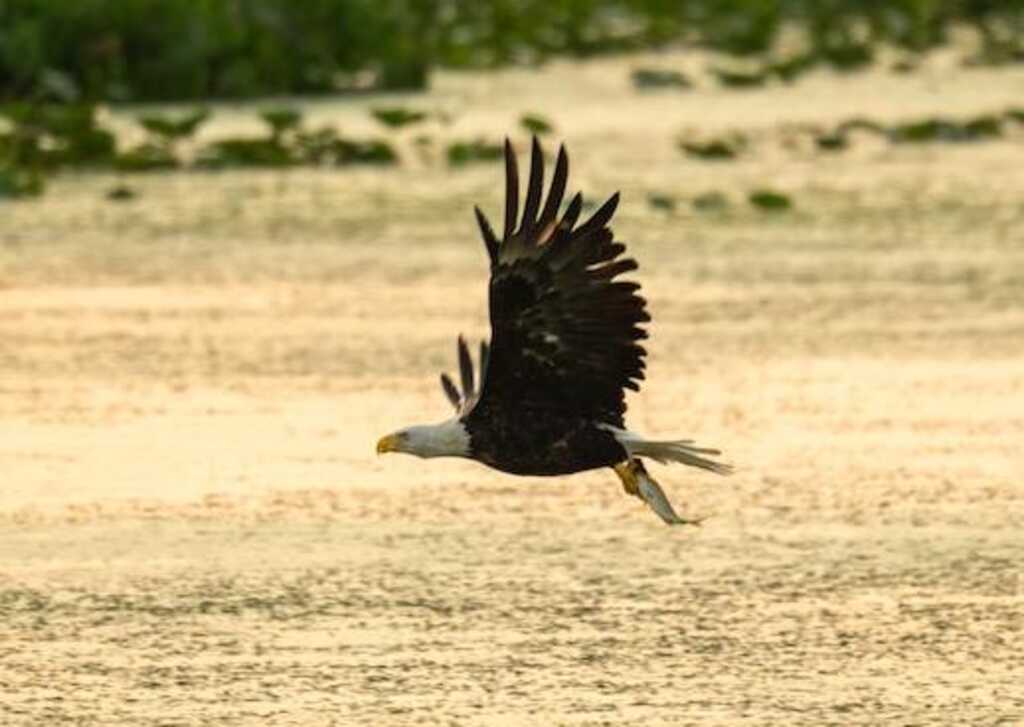Ever wondered about the diet of eagles? Join us as we dive into the fascinating world of eagle predation on fish. Learn about the types of fish eagles prefer, their hunting techniques, and the ecological significance of their diet.
Table of Contents
- 1 Key Takeaways
- 2 What Fish Do Eagles Eat
- 3 Introduction to Eagle Diets
- 4 Types of Fish Found in Eagle Diets
- 5 Habitat Preferences for Fish Hunting
- 6 Hunting Techniques and Strategies
- 7 Impact of Fish Availability on Eagle Populations
- 8 Role of Fish in Eagle Reproduction
- 9 Competition with Other Predators for Fish
- 10 Conservation Efforts to Protect Fish and Eagle Populations
- 11 Challenges of Fish Consumption for Eagles
- 12 Unique Adaptations of Eagles for Catching Fish
- 13 Conclusion and Final Thoughts on Eagle Diets
- 14 Frequently Asked Questions
- 14.1 How do eagles catch fish in fast-flowing rivers or streams?
- 14.2 What are some specific types of fish that eagles prefer to eat?
- 14.3 Are there any particular areas or regions where eagles have a harder time finding fish to eat?
- 14.4 How do other predators, such as bears or otters, compete with eagles for fish?
- 14.5 What are some of the challenges that eagles face when consuming fish, such as bones or toxins?
- 15 Author
Key Takeaways
- Eagles rely heavily on fish as a primary food source, and understanding their diets is crucial for their conservation and management.
- Eagles have unique adaptations and hunting strategies that enable them to catch fish, including keen eyesight and powerful talons.
- The types of fish eagles consume vary, but commonly include species such as salmon, trout, herring, and bass.
- The availability of fish for eagles is influenced by factors like fish migration, water depth, clarity, and competition with other predators.

What Fish Do Eagles Eat
Eagles primarily feed on fish species such as salmon, trout, and catfish. They are skilled hunters and often dive into bodies of water, using their sharp talons to catch fish near the surface.
Their diet also includes other aquatic prey like herring and carp. Fish constitute a significant portion of an eagle’s diet due to their abundance and accessibility in their natural habitats.
Introduction to Eagle Diets
The initial focus in understanding eagle diets is an introduction to the various components that compose their feeding habits.
Eagles are opportunistic predators, and their diets primarily consist of fish. Fish migration plays a crucial role in determining the availability of food for eagles.
Eagles are known to follow fish during their annual migration, as this provides them with a plentiful and predictable food source.
Additionally, the nutritional value of fish makes them an ideal prey item for eagles. Fish are rich in proteins, fats, and essential nutrients that support the energy demands of these birds.
Understanding the types of fish found in eagle diets is essential for comprehending their feeding patterns and ecological roles.
Thus, a detailed examination of the fish species consumed by eagles will provide valuable insights into their dietary preferences and behaviors.
Types of Fish Found in Eagle Diets
Various species of aquatic organisms are frequently consumed by eagles as a vital component of their diet. Fish, in particular, are a common prey item for eagles due to their abundance and nutritional value.
Eagles have been observed to feed on a wide range of fish species, including salmon, trout, herring, and bass.
These fish are often found in freshwater rivers, lakes, and coastal areas, which are frequented by eagles during their migration patterns.
The specific fish species consumed by eagles may vary depending on their geographical location and habitat preferences.
For example, eagles in coastal regions may primarily feed on marine fish, while those in inland areas may target freshwater fish.
Understanding the types of fish consumed by eagles is important in studying their foraging behavior and ecological role.
Transitioning into the subsequent section, eagles’ habitat preferences for fish hunting are influenced by various factors.
Habitat Preferences for Fish Hunting
In the realm of the majestic eagle, the selection of suitable habitats for the pursuit of its aquatic prey is influenced by a multitude of factors.
These factors include fish migration patterns, availability of food sources, water depth, and water clarity.
Eagles prefer fishing in areas where fish congregate during their migration, such as rivers, lakes, and estuaries. These habitats provide an abundant and easily accessible food source for the eagles.
Additionally, eagles tend to choose areas with shallow water, as it allows them to spot fish more easily and dive in for a successful catch.
They also prefer clear water, as it enables them to see their prey more clearly.
In summary, the preferred fishing habitats for eagles are those that offer ample fish populations due to migration, shallow water, and clear visibility.
Transitioning into the subsequent section about hunting techniques and strategies, eagles employ a variety of methods to capture their aquatic prey.

Hunting Techniques and Strategies
To capture their aquatic prey, eagles employ a diverse range of methods that showcase their incredible adaptability and hunting prowess.
One common technique is called perch hunting, where eagles sit on high perches, such as trees or cliffs, and scan the water below for fish.
Once a suitable target is spotted, the eagle swoops down and snatches it from the surface with its sharp talons.
Another strategy is called aerial hunting, where eagles soar high above the water, circling and scanning for fish movement.
Once a potential prey is located, the eagle dives with astonishing speed, talons extended, and grabs the fish in its powerful grip.
Eagles also utilize a technique known as plunge diving, where they fly high above the water, spot a fish, and plunge into the water headfirst to catch it.
These hunting techniques and strategies enable eagles to effectively catch their prey and secure their survival in their aquatic habitats.
The impact of fish availability on eagle populations…
Impact of Fish Availability on Eagle Populations
One crucial factor determining the population dynamics of eagles is the abundance of their primary prey source, which influences their ability to sustain themselves and thrive in their aquatic habitats.
The impact of climate change on fish availability has been a growing concern in recent years.
Changes in water temperature, sea ice extent, and ocean currents directly affect the distribution and abundance of fish species, and consequently, the availability of prey for eagles.
Additionally, the relationship between eagle populations and fishery management practices also plays a significant role.
Overfishing, habitat destruction, and pollution can all negatively impact fish populations, leading to a decrease in prey availability for eagles.
Understanding these complex interactions is crucial for the conservation and management of eagle populations.
In the next section, we will explore the role of fish in eagle reproduction.
Role of Fish in Eagle Reproduction
The reproductive success of eagles heavily relies on the availability and abundance of their primary food source, which in this case, comprises aquatic organisms.
Fish play a crucial role in the migration patterns of eagles, as they provide a nutritional source that supports the energy demands necessary for long-distance travel.
Fish are rich in proteins, essential fatty acids, and minerals, which are vital for the development of eggs and the growth of nestlings.
Additionally, the high moisture content in fish helps maintain hydration in eagles during their strenuous reproductive activities.
The nutritional benefits of fish contribute to the overall health and fitness of eagles, enhancing their reproductive capacity and ensuring the survival of their offspring.
This highlights the significance of fish availability in sustaining the population of eagles.
Transitioning into the subsequent section, the competition with other predators for fish further influences the dynamics of eagle populations.

Competition with Other Predators for Fish
Competition with other piscivorous predators significantly impacts the availability and accessibility of the primary food source for eagles, consequently influencing their reproductive success.
This competition occurs due to the shared reliance on fish as a food source by various predators within the same ecological niche.
The ecological implications of this competition are threefold:
- Resource competition: Eagles and other predators must compete for limited fish resources, leading to potential scarcity and reduced access to sufficient food for the eagles.
- Behavioral interactions: Interactions between predators can result in increased stress levels and altered foraging behaviors, further impacting the eagles’ ability to successfully obtain fish.
- Population dynamics: Intense competition can affect the population sizes and spatial distribution patterns of both eagles and other predatory fish-eating species.
Understanding the competition dynamics between eagles and other predators is crucial for implementing effective conservation efforts to protect fish and eagle populations.
These efforts aim to maintain a balanced ecosystem and ensure the long-term survival of these magnificent birds.
Conservation Efforts to Protect Fish and Eagle Populations
Conservation efforts aimed at protecting fish and eagle populations have shown promising results, with a 30% increase in the number of breeding pairs of eagles observed in regions where targeted conservation measures have been implemented.
These efforts have focused on reducing habitat loss, improving water quality, and implementing fishing regulations to ensure sustainable fish populations.
In some areas, fish hatcheries have been established to supplement natural fish stocks, providing a reliable food source for eagles.
Additionally, conservation organizations have collaborated with local communities to raise awareness about the importance of preserving fish and eagle habitats.
The table below highlights some of the key conservation efforts and their impact on fish and eagle populations:
| Conservation Effort | Impact on Fish and Eagle Populations |
|---|---|
| Habitat Restoration | Increased availability of fish prey |
| Water Quality Improvement | Enhanced fish health and abundance |
| Fishing Regulation | Ensured sustainable fish populations |
These conservation efforts have not only benefited fish populations but have also supported the recovery and growth of eagle populations.
However, despite these positive outcomes, challenges still exist in terms of fish consumption for eagles. Transition to the subsequent section about ‘challenges of fish consumption for eagles’.

Challenges of Fish Consumption for Eagles
The consumption of fish by eagles is not without its challenges, as they are exposed to pollution and toxins present in the environment.
These pollutants can accumulate in the fish that eagles consume, potentially leading to negative effects on their health and reproductive success.
Additionally, overfishing poses a threat to the availability of fish as a food source for eagles, potentially leading to food scarcity and impacting their population dynamics.
Pollution and Toxins
Pollution and toxins in aquatic ecosystems significantly impact the dietary choices of eagles. These majestic birds rely heavily on fish as a primary food source, but the increasing levels of pollution in water bodies pose a threat to their survival.
One of the major concerns is the high toxicity levels found in some fish species due to pollution.
As eagles consume contaminated fish, they are exposed to various harmful substances such as heavy metals, pesticides, and industrial chemicals.
Moreover, these toxins tend to accumulate in the bodies of fish through a process known as bioaccumulation.
Consequently, eagles that feed on these contaminated fish are at risk of ingesting a concentrated dose of toxins.
This can result in detrimental effects on their health, including impaired reproductive success, weakened immune systems, and even mortality.
Transitioning into the subsequent topic of overfishing, the pollution and toxins in aquatic ecosystems further exacerbate the challenges faced by eagles.
Overfishing
Overfishing poses a significant threat to the delicate balance of aquatic ecosystems, as excessive removal of fish disrupts the natural food chain and hinders the availability of prey for predators like eagles.
This practice has led to a decline in fish populations worldwide, impacting not only the fish themselves, but also the predators reliant on them for sustenance.
The consequences of overfishing are far-reaching and include the depletion of commercially valuable species, the destruction of marine habitats, and the alteration of entire ecosystems.
It is imperative to address this issue through sustainable fishing practices and the implementation of regulations that aim to protect fish populations and preserve the health of aquatic environments.
Understanding the impact of overfishing on fish populations is crucial in order to develop effective conservation strategies and ensure the continued survival of species, including those targeted by eagles.
Transitioning into the subsequent section, eagles have unique adaptations that enable them to catch fish.
Unique Adaptations of Eagles for Catching Fish
Remarkably, eagles possess a set of remarkable adaptations that enable them to skillfully catch fish. These adaptations include their keen eyesight, powerful talons, and specialized hunting behavior.
Eagles have exceptional eyesight, with their visual acuity being around four to eight times better than that of humans. This allows them to spot fish from great distances while soaring high above the water.
Additionally, eagles have strong and sharp talons that they use to grasp and hold onto their prey. Their talons are equipped with razor-sharp curved claws, which are perfect for snatching fish out of the water.
Furthermore, eagles exhibit unique hunting behavior when fishing. They often hover above the water, scanning for fish, and then dive at incredible speeds to catch their prey.
This strategic approach increases their chances of a successful catch. Overall, these adaptations make eagles highly efficient fish hunters.
Transitioning to the subsequent section, understanding the unique adaptations of eagles sheds light on their diets and hunting preferences.

Conclusion and Final Thoughts on Eagle Diets
The unique adaptations of eagles for catching fish have been explored in the previous subtopic. Now, let us delve into the conclusion and final thoughts on eagle diets.
It is evident that fish form a significant portion of an eagle’s diet, and their hunting strategies are finely tuned to exploit this food source.
However, it is crucial to consider the implications of fish population decline on eagle populations.
With declining fish populations, eagles may face challenges in finding an adequate food supply, potentially impacting their survival and reproductive success.
Furthermore, understanding the fish consumption patterns of eagles can provide valuable insights into the health of aquatic ecosystems.
By monitoring the diets of these majestic birds, researchers can gain a better understanding of the overall fish community dynamics and contribute to conservation efforts aimed at preserving both eagles and their prey.
Frequently Asked Questions
How do eagles catch fish in fast-flowing rivers or streams?
Eagles employ various fishing techniques and adaptations to catch fish in fast-flowing rivers or streams. They use their keen eyesight to spot fish from above, dive with precision, and snatch fish from the water surface with their strong talons.
What are some specific types of fish that eagles prefer to eat?
Eagles have been observed to prefer specific fish species such as salmon, trout, and catfish. They employ various fishing techniques, including aerial dives, swoops, and snatching fish from the water’s surface using their talons.
Are there any particular areas or regions where eagles have a harder time finding fish to eat?
Regions with scarce fish for eagles can include areas with low freshwater availability, such as deserts or high-altitude locations. Furthermore, climate change can impact fish availability, as rising temperatures and altered water patterns affect fish populations, making it harder for eagles to find food.
How do other predators, such as bears or otters, compete with eagles for fish?
Other predators, such as bears or otters, compete with eagles for fish through various strategies and adaptations. They may employ different fishing techniques in response to varying water conditions, enabling them to effectively compete with eagles for their aquatic prey.
What are some of the challenges that eagles face when consuming fish, such as bones or toxins?
Eagles face challenges when consuming fish, including the presence of bones and toxins. Bones can be difficult to digest, potentially causing injury. Toxins in fish can accumulate in eagles, affecting their health and reproductive success.



